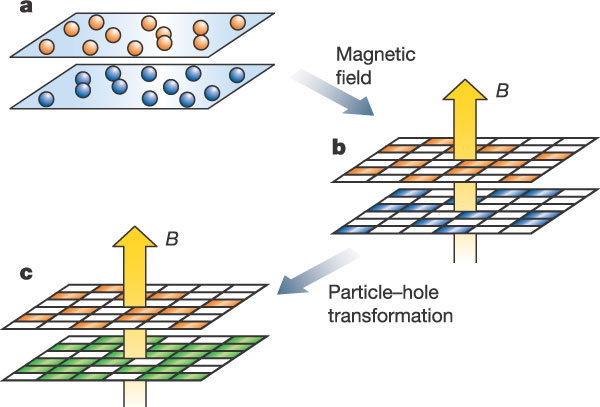
Phase diagram for SU(4) quantum Hall ferromagnetism in the n=0 and n-1 Landau levels of graphene. Phys. Rev. Lett. 96, 256602 (2006)
| Graphene is an atomically two-dimensional electron system made of a single layer of carbon atoms arranged on a honeycomb lattice. Interest in graphene has exploded in recent years because of the achievements of experimental research groups at the University of Manchester and Columbia University who have managed to isolate graphene layers and measure their electrical properties. At low-energies graphene is described by relativistic quantum mechanics with the role of spin played by the psedospin degree of freedom associated with the two atoms in the honeycomb lattice unit cell. Our theoretical research has concentrated on interaction effects in the quantum Hall effect of graphene, which have so far been mainly the appearance of SU(4) quantum Hall ferromagnetism, and on the differences between the Fermi liquid properties of graphene and an ordinary non-relativistic two-dimensional electron system in a quantum well. |
 Phase diagram for SU(4) quantum Hall ferromagnetism in the n=0 and n-1 Landau levels of graphene. Phys. Rev. Lett. 96, 256602 (2006) |
Ferromagnetism in transition metals and transition metal compounds has been
studied for decades and is the basis for much of a major applied physics
subfield, magnetism and magnetic materials. These materials are nonetheless
remarkable because the ordered state is remarkably robust, surviving well
beyond room temperatures. Metal spintronics is the study of the interplay
between magnetic and transport properties in these materials. The major
topic in metal spintronics over recent years has been current-induced-torque
phenomena, mainly spin-transfer phenomena, in which the magnetic order
parameter can be manipulated by the altered exchange fields of a metal which
carries current. Our research has focused on a microscopic picture of the
effect which suggests that it is much more general than had previously been
supposed. We have predicted current induced torques in antiferromagnetic
metals, for example, which appear to have been seen in recent experiments.
[ Go back to top ]
[ Publications ]
Over the past several years an area of theory has built up at the intersection of
condensed-matter and atomic physics. Atomic physicists have learned to cool clouds of atoms
to extremely low temperature where they behave as quantum particles. By taking advantage of
atomic physics phenomena like Feshbach resonances and optical potentials, it is possible to
create systems of strongly interacting quantum atoms. In other words these atomic
vapors act behave like condensed matter systems and not like gaseous vapors.
These cold atoms systems can be used to address some of the most difficult
problems in condensed matter physics from both experimental and theoretical points of
view. Some of the problems that are being studied in our group include
rapidly rotating bosons (the boson quantum Hall effect), fermionic atom systems
near a Feshbach resonance, and quasi-one-dimensional atomic systems.
[ Go back to top ]
[ Publications ]
| The quantum Hall effect occurs in two-dimensional electron systems that are confined to a quantum well or a heterojunction in a semiconductor when the system is placed in a perpendicular magnetic field. The quantum Hall regime has been the source of a multitude of new phenomena in condensed matter physics for over twenty years. The quantum Hall regime is special because cyclotron orbit kinetic energy is quantized. All electrons must lie in macroscopically degenerate Landau levels. (Landau levels are sets of orbitals with the same kinetic energy.) Landau level degeneracy enhances the importance of both interactions and disorder and can lead to ground states with very novel properties, most notably perhaps to states with quasiparticles that have fractional charge and fractional statistics. Recent work in the group has focused either on excitonic superfluidity in quantum Hall systems or on the properties of the one-dimensional electron systems that exist at quantum Hall edges. |
 An electron-electron bilayer system in a strong magnetic field is equivalent to an electron-hole bilayer. Nature 432, 691 (2004) |
| Physicists and chemists have developed a wide variety of different techniques that can be used to create and study either individual or arrays of condensed matter particles that have an overall size that in the nanometer range, so-called nanoparticles. A typical nanoparticle contains from 100 to 10000 atoms. In some cases it has been possible to make electrical contact to an individual nanoparticle. In our group we have been interested in what happens to bulk ferromagnetism in the nanoparticle limit, and in transport through arrays of either paramagnetic or ferromagnetic particles. |
 Planar projection of the total Berry curvature for a 25-atom nanoparticle. Phys. Rev. Lett. 91, 046805 (2003) |